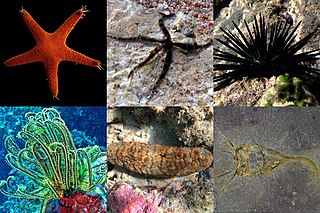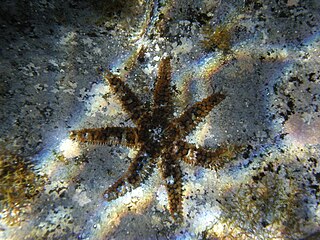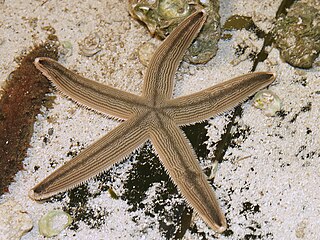
An echinoderm is any deuterostomal animal of the phylum Echinodermata, which includes starfish, brittle stars, sea urchins, sand dollars and sea cucumbers, as well as the sessile sea lilies or "stone lilies". While bilaterally symmetrical as larvae, as adults echinoderms are recognisable by their usually five-pointed radial symmetry, and are found on the sea bed at every ocean depth from the intertidal zone to the abyssal zone. The phylum contains about 7,600 living species, making it the second-largest group of deuterostomes after the chordates, as well as the largest marine-only phylum. The first definitive echinoderms appeared near the start of the Cambrian.

Starfish or sea stars are star-shaped echinoderms belonging to the class Asteroidea. Common usage frequently finds these names being also applied to ophiuroids, which are correctly referred to as brittle stars or basket stars. Starfish are also known as asteroids due to being in the class Asteroidea. About 1,900 species of starfish live on the seabed in all the world's oceans, from warm, tropical zones to frigid, polar regions. They are found from the intertidal zone down to abyssal depths, at 6,000 m (20,000 ft) below the surface.

The crown-of-thorns starfish, Acanthaster planci, is a large starfish that preys upon hard, or stony, coral polyps (Scleractinia). The crown-of-thorns starfish receives its name from venomous thorn-like spines that cover its upper surface, resembling the biblical crown of thorns. It is one of the largest starfish in the world.

Autotomy or 'self-amputation', is the behaviour whereby an animal sheds or discards an appendage, usually as a self-defense mechanism to elude a predator's grasp or to distract the predator and thereby allow escape. Some animals are able to regenerate the lost body part later. Autotomy is thought to have evolved independently at least nine times. The term was coined in 1883 by Leon Fredericq.

Linckia laevigata is a species of sea star in the shallow waters of tropical Indo-Pacific.

The Ophidiasteridae are a family of sea stars with about 30 genera. Occurring both in the Indo-Pacific and Atlantic Oceans, ophidiasterids are greatest in diversity in the Indo-Pacific. Many of the genera in this family exhibit brilliant colors and patterns, which sometimes can be attributed to aposematism and crypsis to protect themselves from predators. Some ophidiasterids possess remarkable powers of regeneration, enabling them to either reproduce asexually or to survive serious damage made by predators or forces of nature. Some species belonging to Linckia, Ophidiaster and Phataria shed single arms that regenerate the disc and the remaining rays to form a complete individual. Some of these also reproduce asexually by parthenogenesis.

The Echinasteridae are a family of starfish in the monotypic order Spinulosida. The family includes eight genera and about 133 species found on the seabed in various habitats around the world.

Linckia is a genus of sea stars found mainly in the Indo-Pacific region. They are known to be creatures with remarkable regenerative abilities, and capable of defensive autotomy against predators. They reproduce asexually.

Heliaster solaris commonly known as 24-rayed sunstar is a possibly extinct sea star which was known from the waters near Española Island in the Galápagos Islands. The species was endemic to the Galápagos Island group, where it appears to have been strictly restricted to the waters around the Isla Espanola.

Linckia multifora is a variously colored starfish in the family Ophidiasteridae that is found in the Indian Ocean and Red Sea. Its common names include the Dalmatian Linckia, mottled Linckia, spotted Linckia, multicolor sea star and multi-pore sea star.

Asexual reproduction in starfish takes place by fission or through autotomy of arms. In fission, the central disc breaks into two pieces and each portion then regenerates the missing parts. In autotomy, an arm is shed with part of the central disc attached, which continues to live independently as a "comet", eventually growing a new set of arms. Fragmentation occurs on star fishes.

Linckia columbiae is a species of starfish in the family Ophidiasteridae. It is found in the East Pacific where it ranges from California (USA) to northwest Peru, including offshore islands such as the Galápagos. Common names include fragile star, Pacific comet sea star and variable sea star.

Luidia clathrata is a tropical species of starfish in the family Luidiidae. It is variously known as the slender-armed starfish, the gray sea star, or the lined sea star. It is found in the western Atlantic Ocean.

Solaster dawsoni, the morning sun star, is a species of starfish in the family Solasteridae. It is found on either side of the northern Pacific Ocean. It has two subspecies:

Thyca crystallina is a species of sea snail, a marine gastropod mollusc in the family Eulimidae. It is one of nine species within the genus Thyca, all of which are parasitic on starfish in the Indo-Pacific Ocean. This species was first described in 1846 by the American conchologist Augustus Addison Gould as Pileopsis crystallina but was later transferred to Thyca.

Neoferdina cumingi, also known as Cuming's sea star, is a species of starfish in the family Goniasteridae. It is native to the tropical Indo-Pacific region.

Echinaster luzonicus, the Luzon sea star, is a species of starfish in the family Echinasteridae, found in shallow parts of the western Indo-Pacific region. It sometimes lives symbiotically with a copepod or a comb jelly, and is prone to shed its arms, which then regenerate into new individuals.

Echinaster is a well-studied and common genus of starfish containing ~30 species and is the second-largest genus found within the family Echinasteridae. The genera Henricia and Echinaster encompass 90% of all the species found within the family Echinasteridae. It contains 30 species, however the number of species in this genus is still debatable because of uncertainty within the genera. This genus is currently sub-divided into two sub-genera: Echinaster and Othilia, evolutionary relationships between the sub-genera is not understood. Echinaster are found in the Pacific, Atlantic and Indian oceans, with most species being studied in the Gulf of Mexico and Brazil. The sub-genera Othilia is thought to encompass species mainly found in the Gulf of Mexico and Brazil. Echinaster is often one of the most studied species within the family Echinasteridae and is often used to find evolutionary relationships.

Starfish, or sea stars, are radially symmetrical, star-shaped organisms of the phylum Echinodermata and the class Asteroidea. Aside from their distinguishing shape, starfish are most recognized for their remarkable ability to regenerate, or regrow, arms and, in some cases, entire bodies. While most species require the central body to be intact in order to regenerate arms, a few tropical species can grow an entirely new starfish from just a portion of a severed limb. Starfish regeneration across species follows a common three-phase model and can take up to a year or longer to complete. Though regeneration is used to recover limbs eaten or removed by predators, starfish are also capable of autotomizing and regenerating limbs to evade predators and reproduce.


















